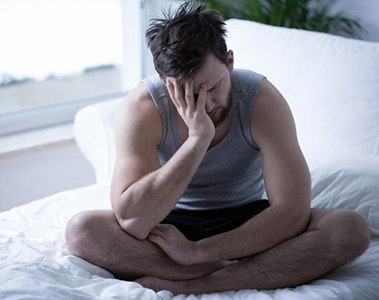Insomnia
Insomnia is the most common sleep disorder in the general population. It involves a reduction in capacity for sleep and can manifest itself in various ways that give rise to different types of insomnia:
- Initial insomnia: problems with falling asleep in less than 30 minutes.
- Maintenance insomnia: problems staying asleep, producing nighttime awakenings of more than 30 minutes or waking up early resulting in an insufficient amount of total sleep time.

Depending on the time of evolution, insomnia can be temporary (just a few days or weeks) or chronic (months or years).

Lack of sleep negatively affects the life of the person suffering from insomnia, causing deterioration in social, occupational, or other important areas.
The number of hours of sleep needed varies from one person to another. Although the daily average is 7 and a half hours, there is a range between 4 (“short sleepers”) to 10 hours (“great sleepers”). These values are considered to be within the normal range.
CAUSES OF INSOMNIA
Medical causes:
-
Metabolic, hormonal, neurological, rheumatological, digestive, and cardiovascular diseases as well as pain disorders (e.g., fibromyalgia, headaches, etc.), or urological disorders with urgency of urination (e.g., urinary tract infections, prostate or kidney problems). Pregnancy and menopause must also be considered.
-
Psychiatric disorders (e.g., anxiety, depression, schizophrenia, etc), as well as other sleep disorders that may lessen or worsen sleep (e.g., restless legs syndrome, parasomnias, sleep apnea syndrome).
External causes:
External causes often involve environmental factors that have a negative influence on sleep (e.g., bad sleep habits, use and abuse of substances and drugs, shift work or frequent transoceanic travel, etc.)
- Primary insomnia: refers to those cases where a clear cause of the disorder cannot be identified. This type of insomnia can also be subdivided into different types according to the manifestation and origin of the problem:
- Idiopathic insomnia: originated in childhood and seems related to learned incorrect sleeping habits.
- Perception of nonrestorative sleep: laboratory studies do not corroborate the sleep problems that the patient subjectively perceives feeling tired and drowsy during the day.
- Psychophysiological insomnia: characterized by a high level of psychophysiological activation associated with the sleep onset. The person suffering from it usually expresses great concern with their sleep problem , making great efforts to try to sleep every night, while sleeping without difficulty when not making this effort. It often improves when the person sleeps in environments that are different from usual. Although it usually coincides with a period of stress, the problem remains for a long time even after the stress disappears or one has become accustomed to it.
Regardless of the cause from which it originates, insomnia can be:
-
Transient: if it is during a short period of less than one month in duration.
-
Chronic: if it extends beyond six months, and may last for years.
If insomnia is secondary to an identifiable cause, it is necessary to deal with this cause in order to resolve the sleep problem. Sometimes, even if the initial cause of the problem is treated, the insomnia remains because the patient is immersed in a vicious cycle that is difficult to escape from. It is this circle in which the anxiety over trying to sleep reduces the chances of falling asleep, increasing apprehension and fear of going to bed. It seems that some personality traits make people more vulnerable to entering this cycle (those with tendencies to worry, experience more anxiety, have difficulty seeing the positive side of things, who are perfectionistis, demanding, controlling, and avoid talking about their problems and internalize negative emotions).
FROM SITUATIONAL OR TRANSIENT INSOMNIA TO CHRONIC INSOMNIA
Chronic insomnia does not develop overnight. It is almost always preceded by a situational insomnia as a result of stressful life events, but fails to improve even when stressors are removed. It can evolve gradually, so that there is increasing concern of the sleep problem and its alleged impact on daily functioning. The assessment we make of the initial difficulty in sleeping is a determining factor in whether the insomnia is a transient problem or a chronic disorder. For example, the person who sleeps poorly for several nights, but continues his daily routine without worrying about this, is unlikely to develop a persistent insomnia. Conversely, a person who after some nights of disturbed sleep begins to worry excessively about not being able to sleep and its negative consequences on daytime functioning, is likely to enter a vicious cycle of insomnia, emotional and cognitive activation, and more sleep disturbances. Having excessive repetitive thoughts about insomnia quickly becomes the center of the person’s worries. The decrease in performance or alterations in mood during the day tend to be attributed exclusively to the sleep problems. In the evening, the apprehension increases as bedtime approaches and the horror of physical activation and being unable to fall asleep magnifies. After a bad night, the person with chronic insomnia is concerned not only about last night, but is already thinking about the next night. Insomnia therefore becomes a self-fulfilling prophecy.
WHAT CAN WE DO TO DEAL WITH INSOMNIA?
From what we’ve seen previously, in order to break the cycle, it is important to change the factors that are contributing to perpetuating insomnia. In other words; change the inappropriate habits, which originally arose as an attempt to alleviate its negative effects, change the erroneous thoughts that increase the worry, and reduce the high emotional activation associated with these variables.
For this reason, it is important to take an active role in the change of these aspects. You will have our support and guidance, but the patient has to follow the guidelines we provide to deal with insomnia. These guidelines have been developed in clinics around the world and have proven to be effective in other patients suffering from insomnia. Although it is not a miracle cure, this treatment helps patients develop skills for self-control of insomnia and regain control over sleep, so that occasional sleep difficulties that may be encountered even after completing this program do not pose a problem. The program requires time, patience and effort. To achieve the goal of sleeping quickly and reducing the time spent awake in the middle of the night, it is important to complete all the requirements, as opposed toselecting only those that seem the least difficult. The benefits will become more obvious with time and continued practice. The consistency with which the instructions are followed is the most important factor in determining the results, which may begin to show after a few weeks of treatment.
This intervention consists of three components; behavior change, thought change and activation reduction.
-
We will regulate the time for going to bed and getting up, and will consolidate sleep within a shorter period of time in bed. This will lead to a situation of “sleep deficit”, and when done continuously, forces the brain centers responsible for sleep to reprogram, consolidating sleep in the form of deeper and more continuous rest. It is common for insomniacs to sleep late in the morning, take naps during the day, or simply spend more time in bed to compensate for their sleep deficit. We will do the following;
- Limiting the time we spend in bed to the amount of hours that we actually sleep.
- Maintaining a regular time for getting up.
- Eliminating naps during the day.
-
We will reduce the activities that interfere with sleep. The main objective is to associate the bed, bedtime and surroundings of the bedroom with feeling of relaxation, drowsiness and sleep, instead of with frustration, activity, and insomnia. To do so;
- Go to bed only when you are sleepy.
- If you can not get to sleep after 10-15 minutes of trying to relax, get out of bed, continue relaxing according to the learned method and go back to bed again only when you are sleepy.
- Repeat this operation as many times as necessary throughout the night. If after the relaxation you do not feel sleepy, perform some kind of monotonous and boring activity outside the bedroom that does not require concentration and is not interesting to you.
- Use the bed and the bedroom only for sleep. Do not watch television, listen to the radio, nor eat or read in bed.
- We will influence lifestyle: diet, sport, regular hours, limiting tobacco consumption and alcoholic beverages.
-
We will evaluate attitudes and beliefs about sleep and insomnia. How people think about a specific problem can either lighten or aggravate it. What you think also affects what you feel and do. For example, when you worry during the day about how badly you slept the previous night, it is likely that this will make you feel more apprehension towards the next night. An excessive preoccupation with the consequences of bad sleep can also feed your problem. Excessive concerns and emotional distress are not exactly sleep inducers. Therefore, this component of the treatment is designed to help you address these concerns. To achieve greater self-control over sleep, you should set aside your previous convictions and replace them with others that are more adaptive.
We will try to get voluntary control of your physiological activation, learning to relax your body and your mind whenever you need it, but above all at bedtime, since it is sufficiently proven that emotional activation hinders and prevents sleep, in addition to compromising your well-being and quality of life.
MEDICATIONS
Medications should not be taken without a prescription. Each case must be individualized, assessing the benefits of treatment, if this is truly indicated. At the Sleep Institute we try not prescribed hypnotics except for exceptional cases.
Hypnotic pharmaceuticals (benzodiazepines, zolpidem, zaleplon): are often prescribed in cases of transient insomnia.
Antidepressants (fluoxetine, trazodone, mirtazapine): affect mood and the latter two also act as hypno-regulators, modifying the structure of sleep.
In general, treatment time is limited, to limit the emergence of side effects.